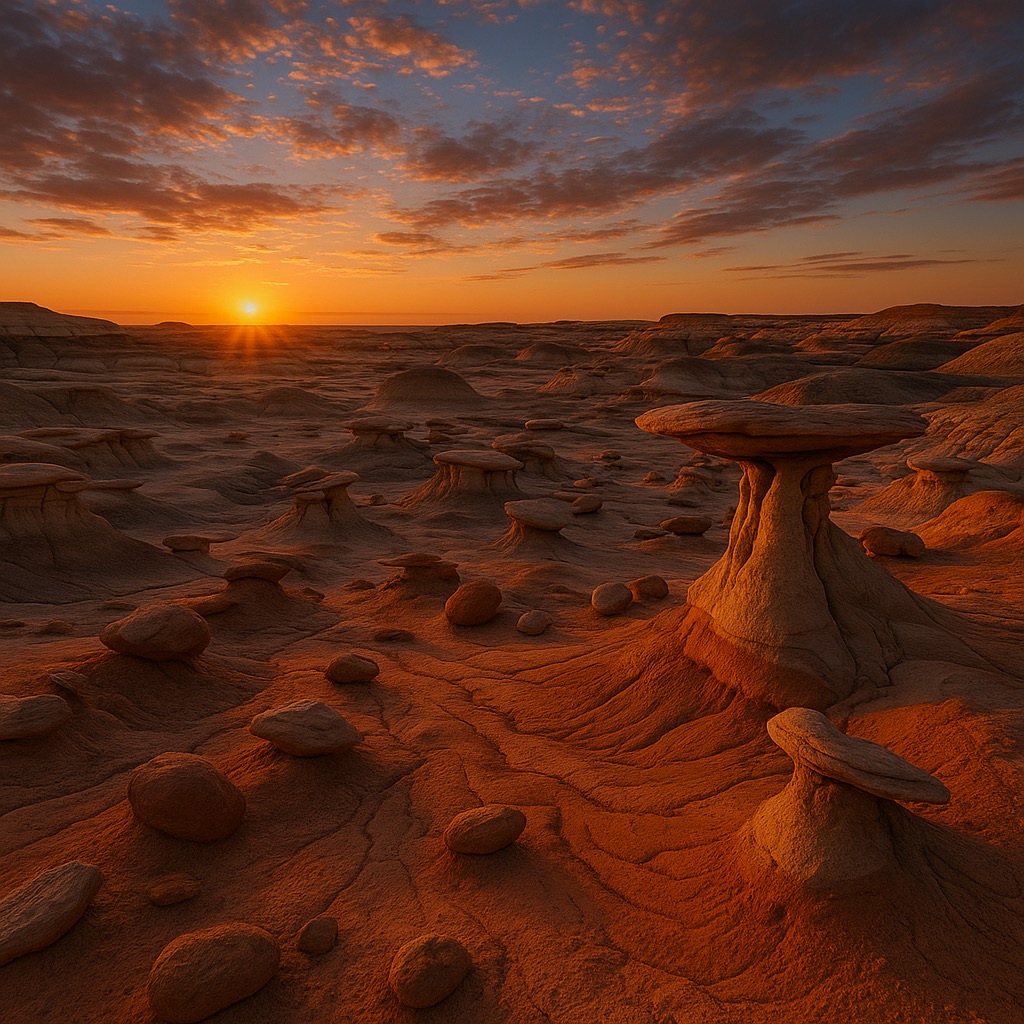
Bisti Badlands, New Mexico: Explore Surreal Mars-Like Desert Formations and Fossils
The Bisti Badlands in northwestern New Mexico offer a rare glimpse into a landscape that looks like it belongs on Mars. This remote wilderness covers about 45,000 acres of striking rock formations shaped over millions of years. Managed by the Bureau of Land Management, it’s a protected area where you’ll find sharp spires, natural arches, and colorful hoodoos sitting atop layers of ancient sediment.
These sculpted badlands hold more than just unique geology. Within this quiet desert, fossils from the age of dinosaurs and prehistoric plants tell stories from long ago. If you’re drawn to off-the-beaten-path spots with unusual terrain and rich history, the Bisti Badlands are a must-see. Just be ready for rugged trails and simple access—nature here stays wild and mostly untouched.
Geological Wonders and Unique Landforms of Bisti Badlands
Stepping into the Bisti Badlands feels like entering a surreal, otherworldly scene. The eerie rock shapes and barren terrain look like something right out of a Mars mission. But this landscape has its own story—a tale etched in stone over millions of years. Let’s explore how the Bisti Badlands formed, and what makes its puzzling rock structures so strikingly unique.
Geological History and Formation Process
The story begins in the Late Cretaceous period, roughly 70 million years ago, when this area was a vast river delta. Over time, layers of sediments—a mix of sand, mud, and volcanic ash—built up here. These layers eventually hardened into sedimentary rock as minerals like iron and quartz cemented the particles together.
Volcanic ash played an important role too. When eruptions blanketed the landscape, the ash settled into the sediments, altering their composition and colors. This helped create the distinctive streaks of white, gray, and red that paint the badlands today.
As the land was lifted by tectonic forces, the region faced millions of years of erosion. Wind and water carved into the soft sedimentary layers, sculpting the jagged pinnacles and twisting spires we see now. The harder layers resisted erosion and acted like protective caps, allowing the formations below to weather unevenly. This slow but steady sculpting process continues today.
The Bisti Badlands offer a perfect example of how geologic time shapes raw earth into fascinating works of natural art. For more details on the geologic formations in this region, you can visit the New Mexico Bureau of Geology and Mineral Resources.
Distinctive Rock Formations and Features
The real charm of Bisti lies in its strange, eye-catching rock shapes. Here are some of the most famous:
- Hoodoos: These are tall, thin spires of rock with a harder stone “cap” on top. The cap protects the softer sandstone beneath, leading to those distinctive mushroom-like forms. Their irregular shapes make them look like alien sentinels guarding the desert floor.
- Limestone-capped towers: Similar to hoodoos, these towers rise sharply and are capped by tough limestone plates. These caps give the towers a layered appearance, and the sharp contrast in texture plays with light and shadow, creating a sense of depth and mystery.
- The Cracked Eggs: Rounded boulders sitting on flat surfaces, these formations have cracked, crusty exteriors that resemble giant eggshells breaking open. Their unusual shape and texture spark curiosity and add to the area’s surreal vibe.
- Wings on the Flats: This formation looks like giant stone wings or sweeping curtains frozen in time. The smooth curves and delicate edges seem to defy gravity and add a sense of motion to the still landscape.
These features combine to create a visual effect that feels far from Earth. The mix of colors, sharp contrasts, and odd shapes sometimes makes you wonder if you might be walking on Mars. You can learn more about how weathering and erosion shape these formations in detail from GeologyScience’s Bisti overview.
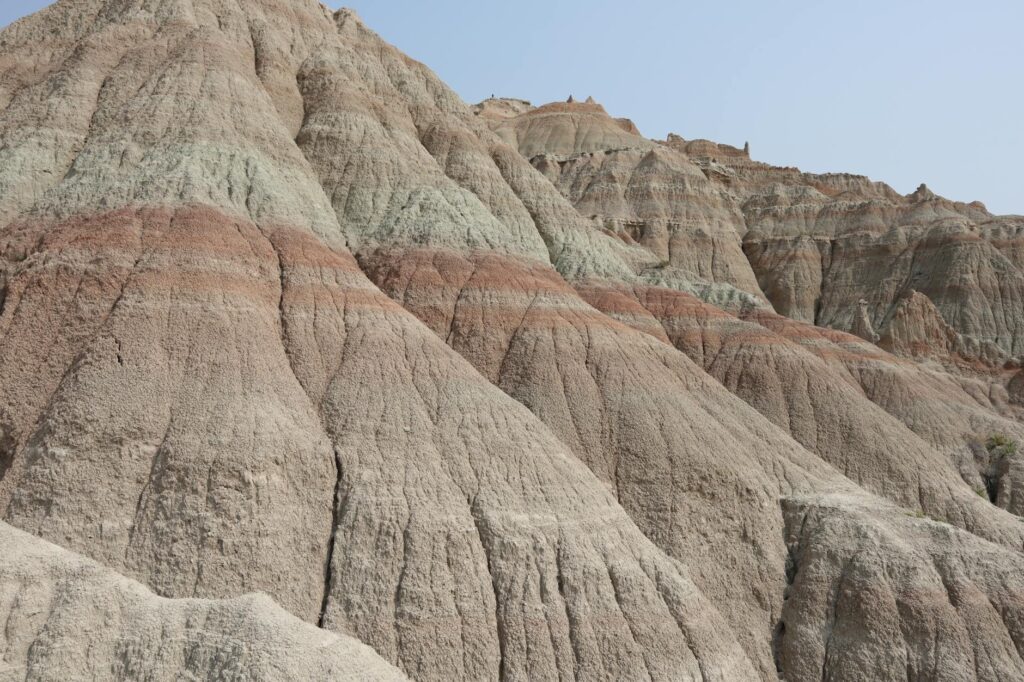
Photo by Michael
Nature’s ability to sculpt such odd, abstract shapes from layers of dirt and ash is a powerful reminder of time and erosion’s quiet handiwork. Exploring Bisti makes you appreciate how patiently the Earth crafts its most unusual landscapes.
Fossils and Paleontology: Window into Prehistoric Life
The Bisti Badlands are more than a bizarre land of sculpted rock—they are a treasure trove for anyone interested in prehistoric life. Beneath the surreal desert surface lie fossils that offer a glimpse into ecosystems from tens of millions of years ago. These remnants bring the ancient past to life, helping us understand animals and plants that once roamed this region when it felt nothing like the arid wilderness we see today. Let’s explore some of the most significant fossil finds and the remarkable geological layers that preserve evidence of dramatic changes in Earth’s history.
Significant Fossil Discoveries
The Bisti Badlands have yielded an impressive variety of fossils, including some of the most important dinosaur remains in North America. Among these discoveries are:
- Hadrosaurs: Often called “duck-billed dinosaurs,” hadrosaurs were common herbivores in this region. Their well-preserved bones show detailed features like crests and teeth adapted for a plant-based diet.
- Ceratopsians: These horned dinosaurs, relatives of the famous Triceratops, have been found in various fragments. Their skulls and horns provide valuable insight into the diversity of dinosaurs just before the end of the Cretaceous period.
- Theropods: The “Bisti Beast” (Bistahieversor sealeyi) is a notable carnivorous theropod discovered here. It gives us clues about the predators that roamed alongside herbivores in this ancient ecosystem.
- Mammals and smaller reptiles: Beyond dinosaurs, fossils of early mammals and various reptiles paint a picture of a diverse and thriving prehistoric world. These smaller creatures add depth to our understanding of the food web and environmental conditions of the time.
There’s a sense of walking through a natural history museum scattered across the desert floor, with each find contributing a piece of the puzzle. Recent finds even include partial skeletons that offer exciting insights into how these creatures lived and interacted. For detailed stories about these fossils, the New Mexico Museum of Natural History & Science’s exhibit on the Bisti Beast is a fantastic resource.
Scientific Importance of the K-T Boundary Layers
One of the most fascinating features of the Bisti Badlands is the presence of well-preserved K-T boundary layers. This thin layer of sediment marks where the Cretaceous period ended about 66 million years ago and the Paleogene period began—a point in time famously linked to a massive extinction event.
This boundary layer acts like a geological timestamp that captures the fallout of one of Earth’s most significant biological turnovers:
- It contains traces of a sudden drop in dinosaur fossils and a rise in species that survived the extinction.
- Scientists find rare minerals and evidence of asteroid impacts buried in this layer, supporting the theory that an asteroid collision contributed to the mass extinction.
- The fossils found above and below the K-T boundary help researchers understand how ecosystems transformed after the dinosaurs disappeared.
Studying these layers at Bisti helps piece together not only what happened during this cataclysm but also how life began to recover afterward. This contributes to broader knowledge about extinction events and how life on Earth responds to sudden environmental changes. You can learn more about this boundary and its global impact on life from the Lunar and Planetary Institute’s overview on the K-T boundary.
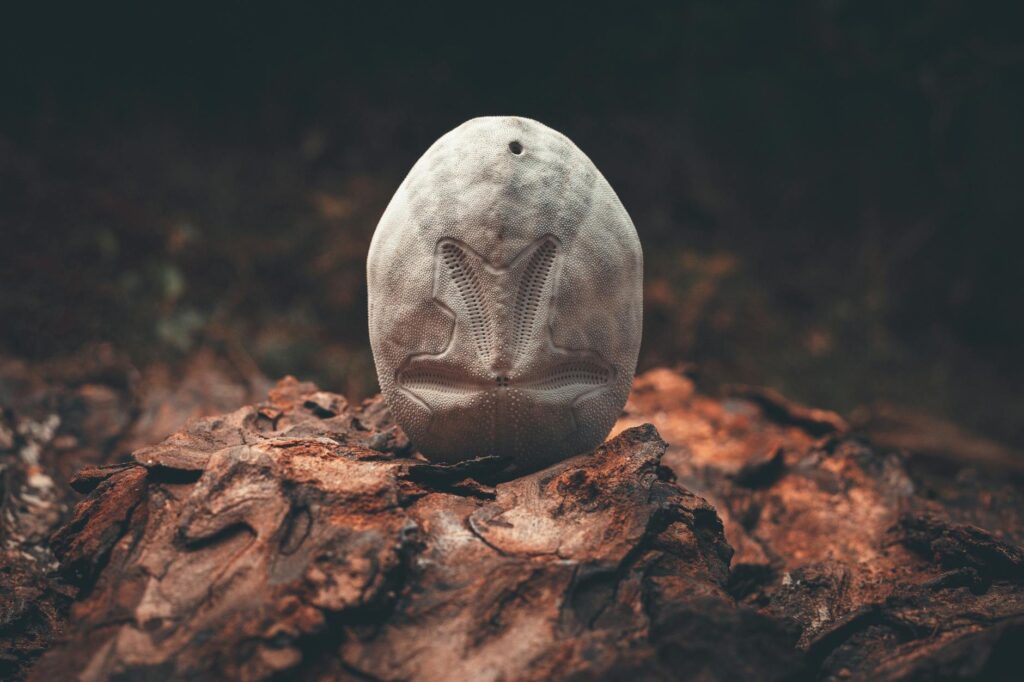
Photo by Roberto Lee Cortes
Exploring the Bisti Badlands lets you trace life’s story across a time when dinosaurs ruled and then vanished—offering a rare and vivid glimpse into prehistoric life and the forces that shaped today’s living world.
Planning Your Visit to Bisti Badlands
Visiting the Bisti Badlands is an adventure that requires some preparation. This remote area has no developed trails or visitor facilities, so understanding how to reach it, when to go, and how to stay safe will help you enjoy your trip without surprises. Let’s break down what you need to know before you head into this mars-like desert.
How to Get There and Access Points
The Bisti Badlands are tucked away in northwestern New Mexico and can be reached primarily by dirt roads off New Mexico State Highway 371. The main access point is about 36 miles south of Farmington, at a turn off for Road 7297, also known locally as the trailhead to Bisti Wash.
- The dirt roads leading to the site can be rough and uneven, so a high-clearance vehicle is recommended.
- Since the roads are unpaved and can get tricky after rain, having a detailed map or GPS is essential to avoid getting lost.
- No paved paths or marked trails guide you inside the wilderness. The terrain is natural and often challenging to navigate, meaning you’ll need solid navigation skills.
- There are no facilities like restrooms or water stations, so plan accordingly.
More details about reaching the area are available on the Bureau of Land Management’s Bisti/De-Na-Zin Wilderness page which offers maps and directions.
Best Times to Visit and Weather Considerations
To enjoy Bisti Badlands comfortably, timing your visit matters. The desert environment can be harsh if you’re unprepared.
- Spring and Fall are the best seasons to visit. Temperatures are mild, ranging roughly between 60-80°F, making hiking and exploring much more pleasant.
- Summer brings soaring heat, often above 90°F, which can be dangerous especially without shade and water. The sun here is intense and relentless.
- Winter is cold, and temperatures can drop below freezing, with occasional snow. The landscape remains dramatic but will require warm clothing and caution on icy terrain.
Spring can be windy, so be prepared for bouts of blowing sand. Fall generally offers more stable weather for outdoor activities. For visitor reports and recent weather insights, TripAdvisor’s page on Bisti Badlands gives useful traveler feedback.
Visitor Tips for Safety and Enjoyment
Since Bisti Badlands is a wild, undeveloped desert, safety depends on how well you prepare. Here are some tips to keep your visit safe and enjoyable:
- Carry plenty of water. Aim for at least one gallon per person per day to stay hydrated.
- Wear sturdy shoes and layered clothing. Strong hiking boots will help on uneven ground. Layers protect you from temperature swings and wind.
- Use a compass and GPS device. Cell service may be spotty or nonexistent. Practice basic navigation before heading out.
- Don’t rely on marked paths. Use maps and landmarks to keep track of your location.
- Follow Leave No Trace principles. Pack out all trash, avoid disturbing rock formations, and leave fossils where you found them to preserve this fragile environment.
- Tell someone your plans. Let a friend or family member know your route and expected return time in case of emergency.
For more outdoor safety tips and ethical guidelines for wilderness areas, check out the US Forest Service recommendations for outdoor safety and ethics.
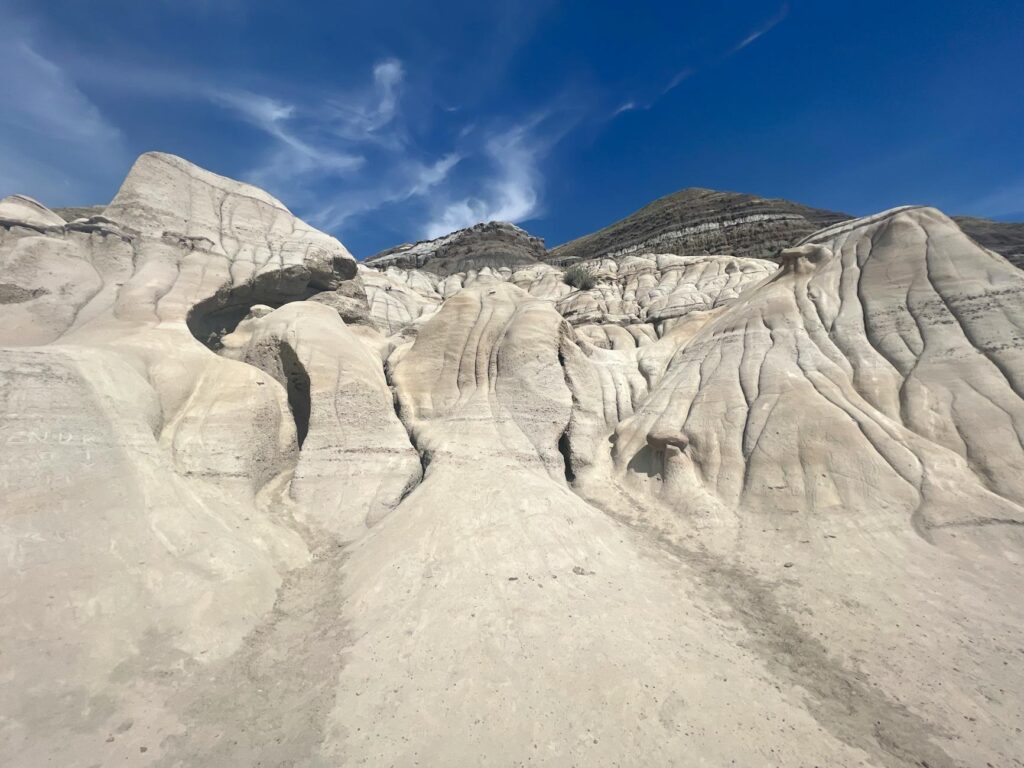
Photo by Hardeep Singh
With a bit of planning and respect for the environment, your trip to Bisti Badlands can be a memorable experience walking through a landscape unlike any other on Earth.
Photography and Filmmaking in Bisti Badlands
The Bisti Badlands offer a treasure trove for photographers and filmmakers drawn to one-of-a-kind, alien-like scenes. With shapes that look molded by another planet, this place attracts those who want to capture something breathtakingly unusual. The quality of light, textures on the rocks, and vast open spaces come together to create images that look almost unreal. Whether you’re a photographer aiming for the perfect shot or a filmmaker scouting dramatic backdrops, Bisti Badlands never disappoints.
Photography Techniques and Best Locations
Capturing the essence of Bisti Badlands demands both timing and equipment choices to bring out its surreal qualities. Golden hour—the first hour of light after sunrise and the last hour before sunset—casts warm, soft hues that highlight the intricate textures and vibrant colors. Shadows stretch long and deepen, sculpting the odd shapes with contrast that makes them pop.
To fully embrace the vastness and detail, a wide-angle lens is often the best tool. This lens captures sweeping views that include multiple rock formations or hoodoos in one frame, drawing viewers into the expansive scene. It also lets you get close to foreground details without losing the dramatic background.
Some of the most popular spots where photographers find stunning compositions include:
- The Cracked Eggs: Their rounded, cracked surfaces glow beautifully with warm light.
- Wings on the Flats: The stone wings are perfect for wide shots that show their delicate, curved edges.
- Hoodoos: Early or late light enhances their layered textures and towering forms.
It’s worth exploring different angles—sometimes shooting low near the ground or framing with a narrow depth of field to isolate a single detail makes for powerful images. Some photographers even experiment with long exposures at twilight to add a dreamy quality to the sky.
For more detailed tips, the guide from Firefall Photography offers practical advice on photo spots and composition around Bisti Badlands.
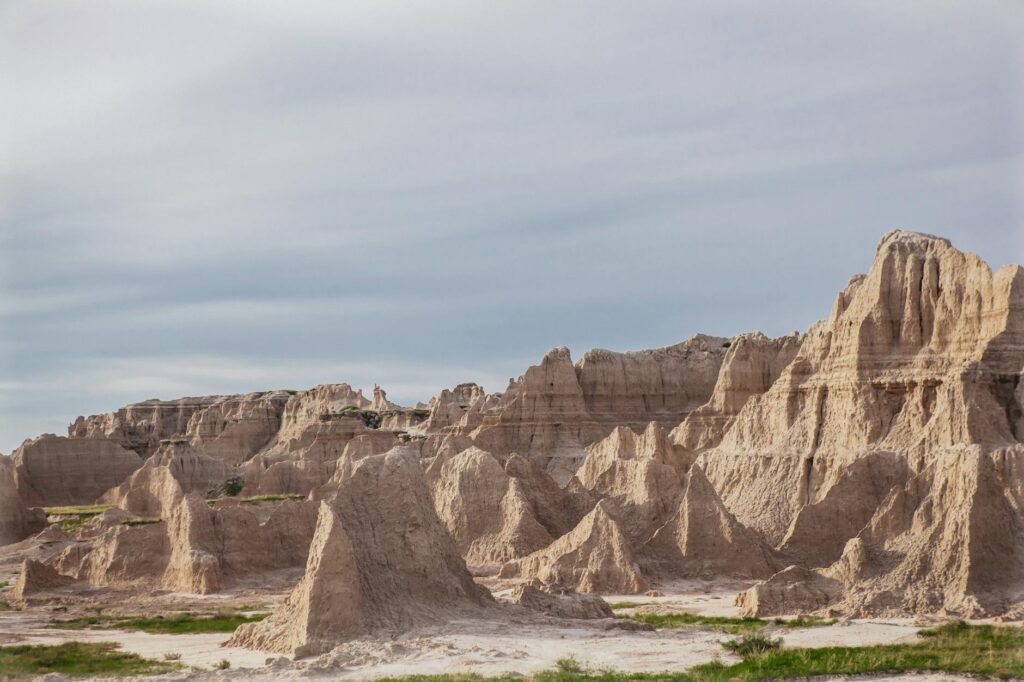
Photo by Ekaterina Belinskaya
Film and Media Productions Featuring Bisti Badlands
Bisti’s unusual terrain and striking colors have captured the attention of filmmakers and media producers looking for otherworldly settings. Its resemblance to a Mars surface makes it an ideal backdrop for sci-fi scenes, documentaries, and commercials that want a rugged, alien feel.
Several productions have used Bisti to visually transport audiences to remote worlds. Notably, it’s been featured in sequences for the science documentary series Cosmos, where the landscape added authenticity to cosmic storytelling. It also attracts smaller commercial projects aiming for strong visual impact.
Filmmakers sometimes use artificial lighting at night to spotlight specific rock formations, creating eerie glows and deep shadows that heighten the surreal vibe. These light setups emphasize textures and contours invisible in natural daylight, giving scenes an almost fantasy-like quality.
The area benefits from clear, dark skies, making it perfect for night shoots where stars and rock formations combine for unforgettable visuals. Local film offices continue to promote the region for its unique appeal and growing support for productions in San Juan County, New Mexico.
For updates on filming activity and incentives, the New Mexico Film Office and local filmmaking groups provide useful information on ongoing projects in the Bisti area.
Together, the natural scenery and thoughtful use of light create a setting that is not only visually striking but inspiring for creative storytelling.
For readers interested in practical photography tips and insider details, the Photographer’s Trail Notes guide to Bisti Badlands is very helpful. For filmmakers, the New Mexico Film Office’s page on Bisti Wilderness Productions provides useful insights on recent filming in the area.
Cultural and Historical Significance of the Bisti Badlands
The Bisti Badlands are more than just strange rock formations and fossils. This land holds deep importance for the Navajo people and offers clues to ancient human activity. The names “Bisti” and “De-Na-Zin” reflect centuries-old connections between people and place. Understanding these cultural and archaeological layers adds a meaningful dimension to exploring this wild and remote area.
Navajo Heritage and Naming
The word Bisti comes from the Navajo term Bistahí, which roughly means “a large area of shale hills” or “among the adobe formations.” This reflects the region’s soft, eroded badlands stretching across miles. The name captures how the land looks—uneven, layered, and weathered—an impressive feature to the Navajo who know it as home.
The adjacent wilderness is also known as De-Na-Zin, which translates from Navajo as “standing crane” or specifically Dééł Náázhíní. This name ties into the cultural and spiritual world of the Navajo. The standing crane is a respected figure in Navajo stories and ceremonies, symbolizing grace, balance, and vigilance. Some of the Bisti formation shapes resemble the posture of cranes, bridging nature and culture in the landscape.
This region is part of a living homeland for the Navajo Nation. It remains a place of respect and traditional stories. Visitors should appreciate that these names are not just labels but reflections of a long-standing relationship with the land. To learn more about the Navajo perspective on Bisti and its names, check the Bisti Badlands/De-Na-Zin Wilderness official page.
Archaeological Insights and Ancient Trails
The Bisti Badlands lie near important archaeological routes used by ancient peoples, including the Ancestral Puebloans. One notable example is the Great North Road, a prehistoric trail running from Chaco Canyon, a major cultural center, northward across the region. This path connects ancient villages, ceremonial sites, and natural landmarks, weaving human history into the desert’s fabric.
In and around Bisti, traces of ancient human footprints and artifacts hint at the area’s long use and significance. These footprints represent people passing through or resting in the badlands thousands of years ago. Archaeologists continue to study these signs, seeking to protect and preserve this fragile connection to the past alongside the natural preservation efforts in the wilderness.
The balance of protecting archaeological treasures and the wild environment is a priority. Visitors are encouraged to respect the land by not disturbing any visible artifacts or formations. To explore more about these archaeological efforts and the region’s deep history, the Bureau of Land Management’s Bisti/De-Na-Zin Wilderness page offers detailed information.
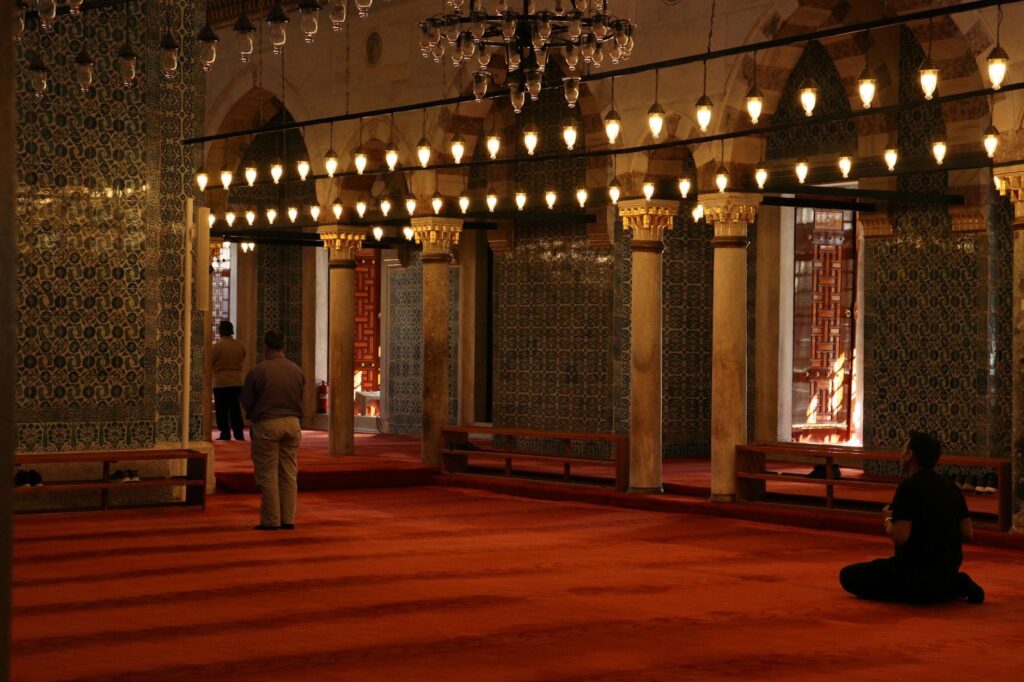
Photo by Esra
Recognizing these layers of culture and history deepens your visit to Bisti. It’s not just a strange land of rock—it’s a place where people, past and present, connect with the earth in profound ways.
Conclusion
Bisti Badlands stands out as a destination that offers something rare for adventurers, artists, scientists, and culture seekers. Its Mars-like terrain presents stunning rock formations and colors carved over millions of years, making every step feel like exploring another planet. The area’s fossils and ancient layers reveal stories that connect us to deep time, while the cultural ties of the Navajo add meaningful history.
Visiting Bisti lets you experience a vast, untamed desert that feels both wild and timeless. Whether you’re hiking, photographing, or simply soaking it all in, the Badlands deliver an unforgettable encounter with nature’s artistry and earth’s ancient past.
Take the time to prepare well, respect the land, and you’ll discover why Bisti Badlands continues to inspire and captivate everyone who ventures into its surreal spaces. It’s a place that leaves a lasting impression and calls for more exploration beyond the trail.
